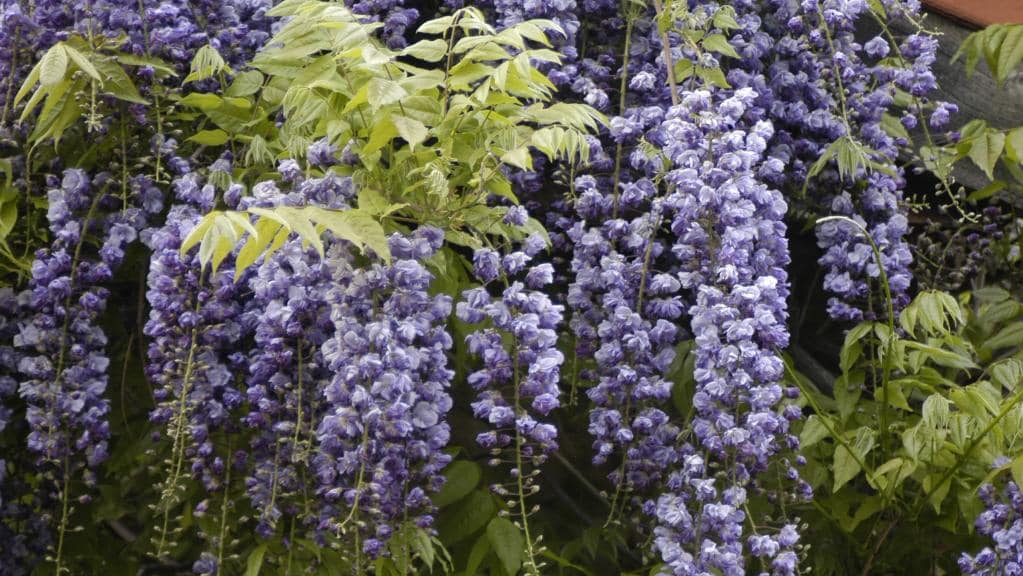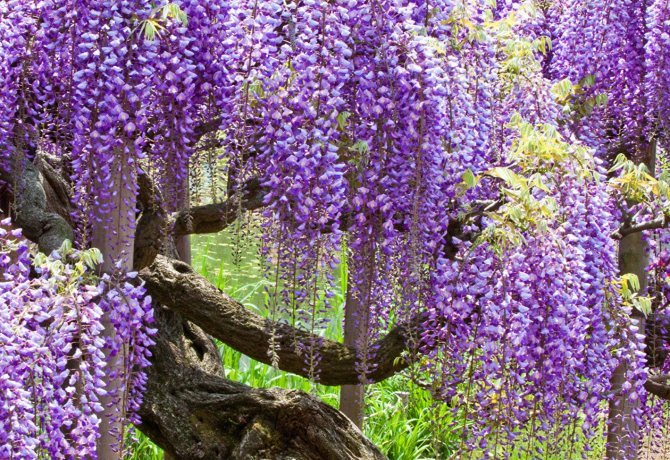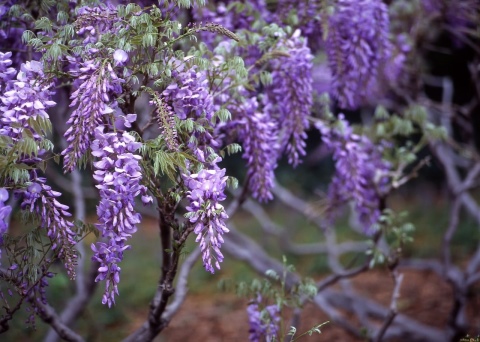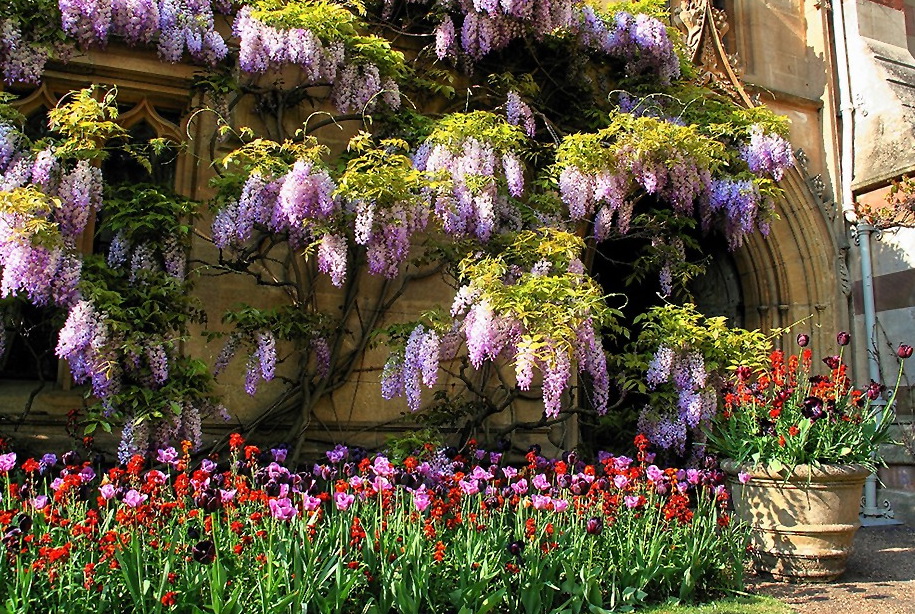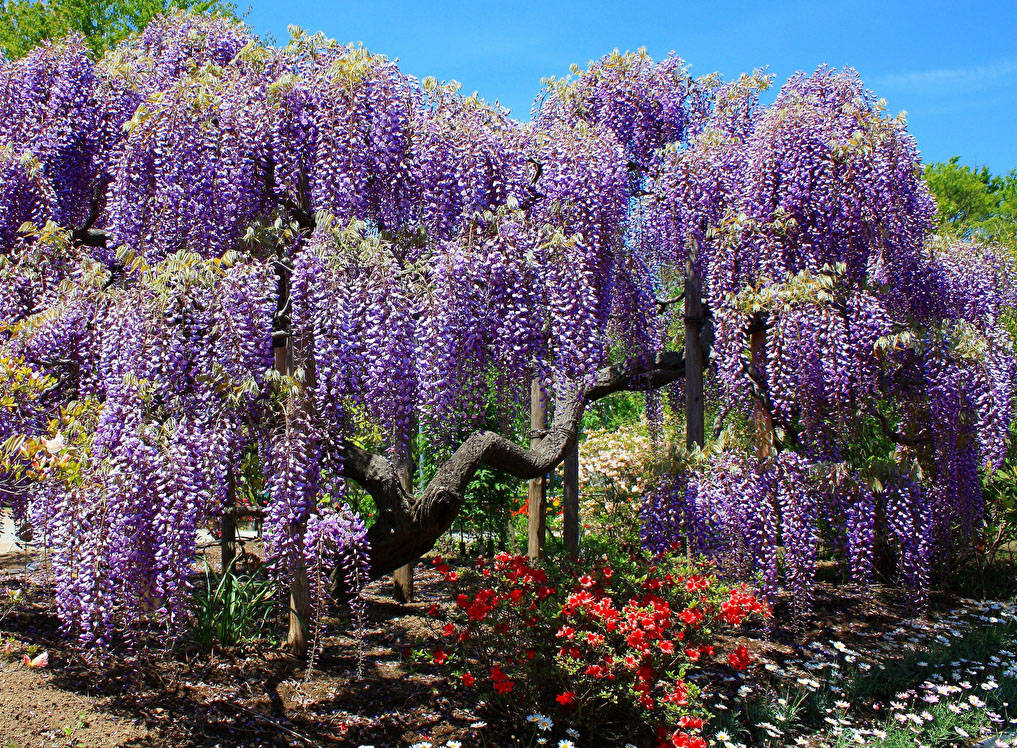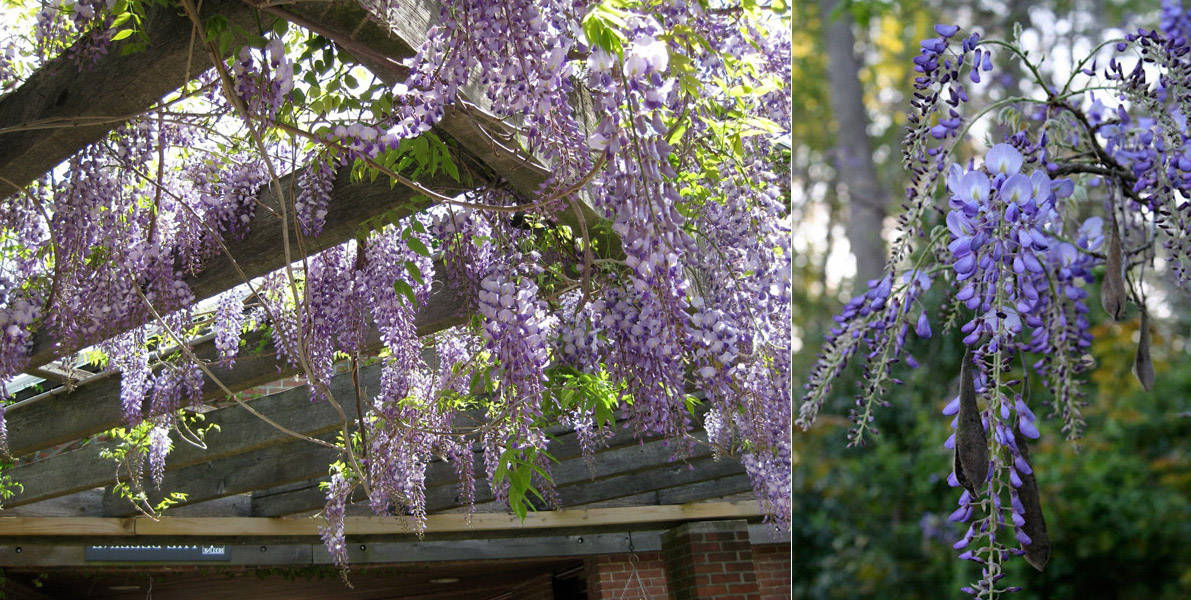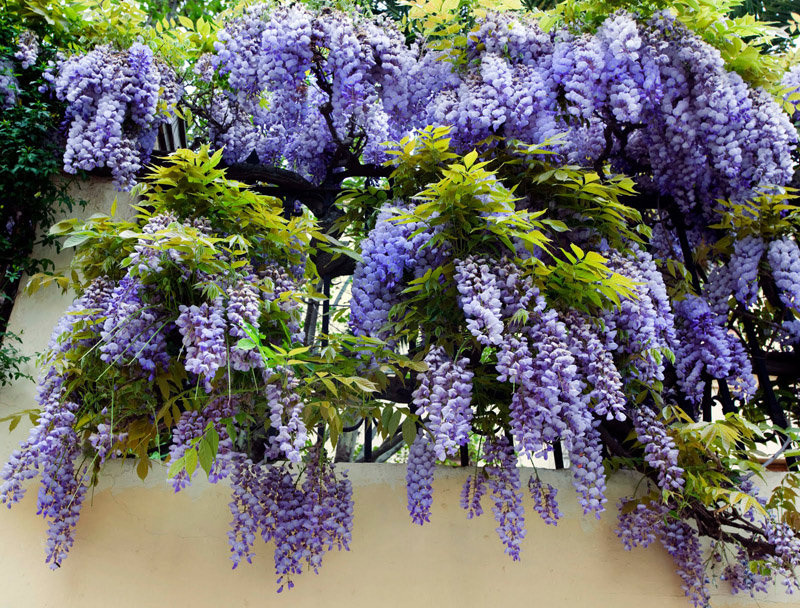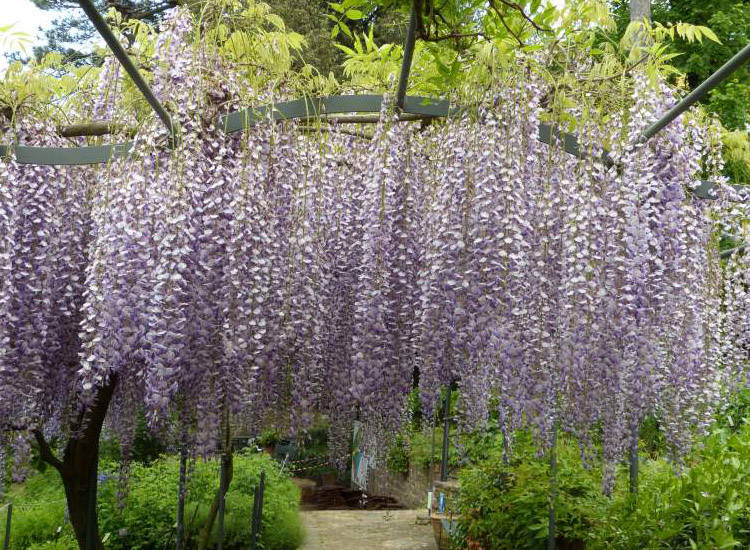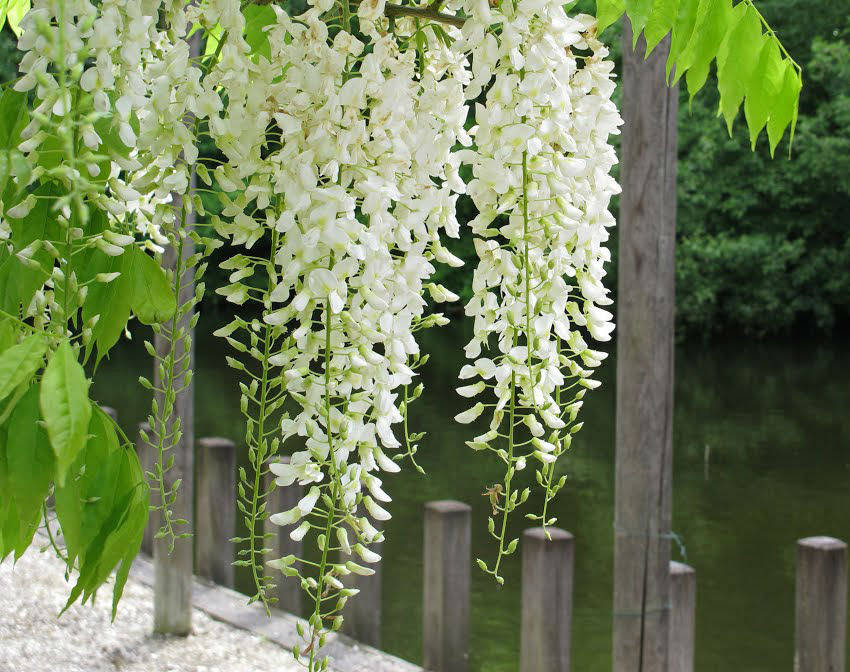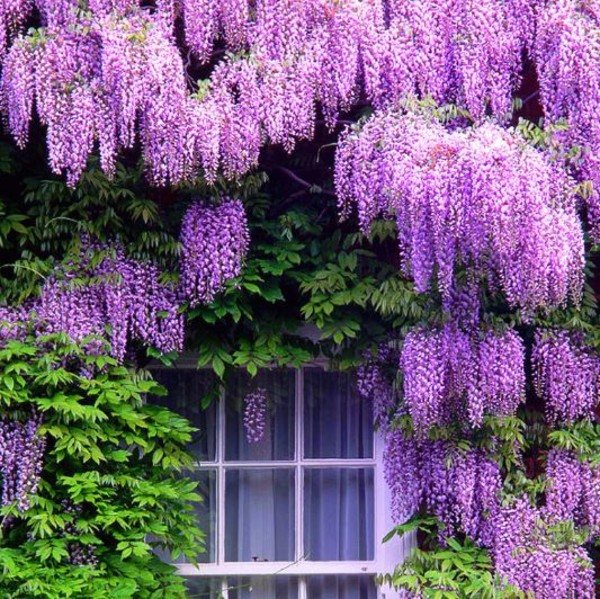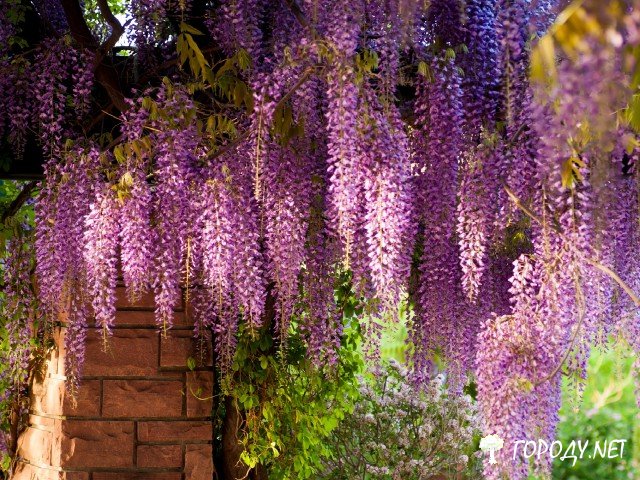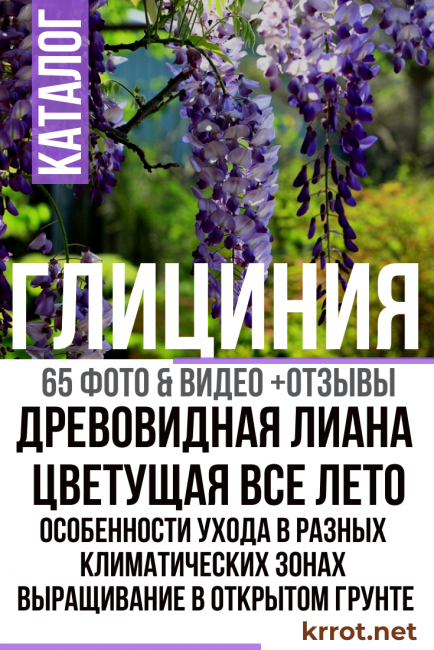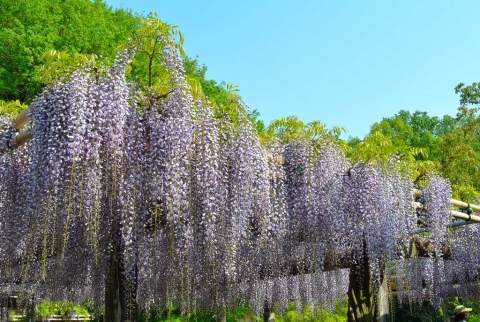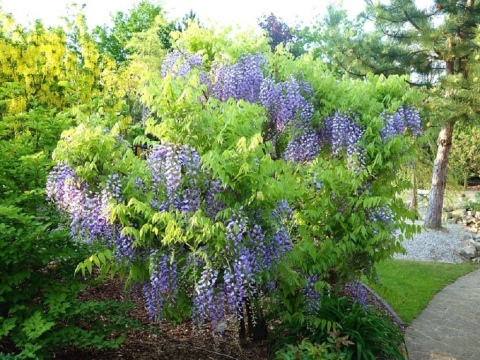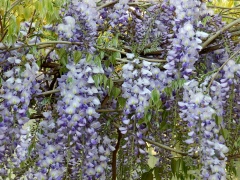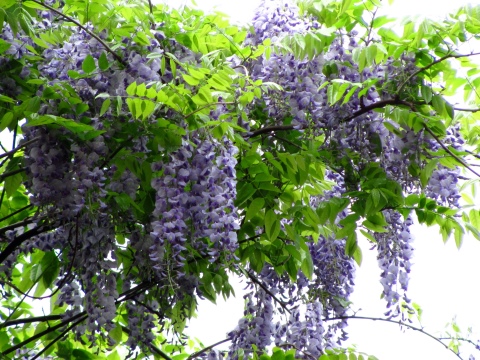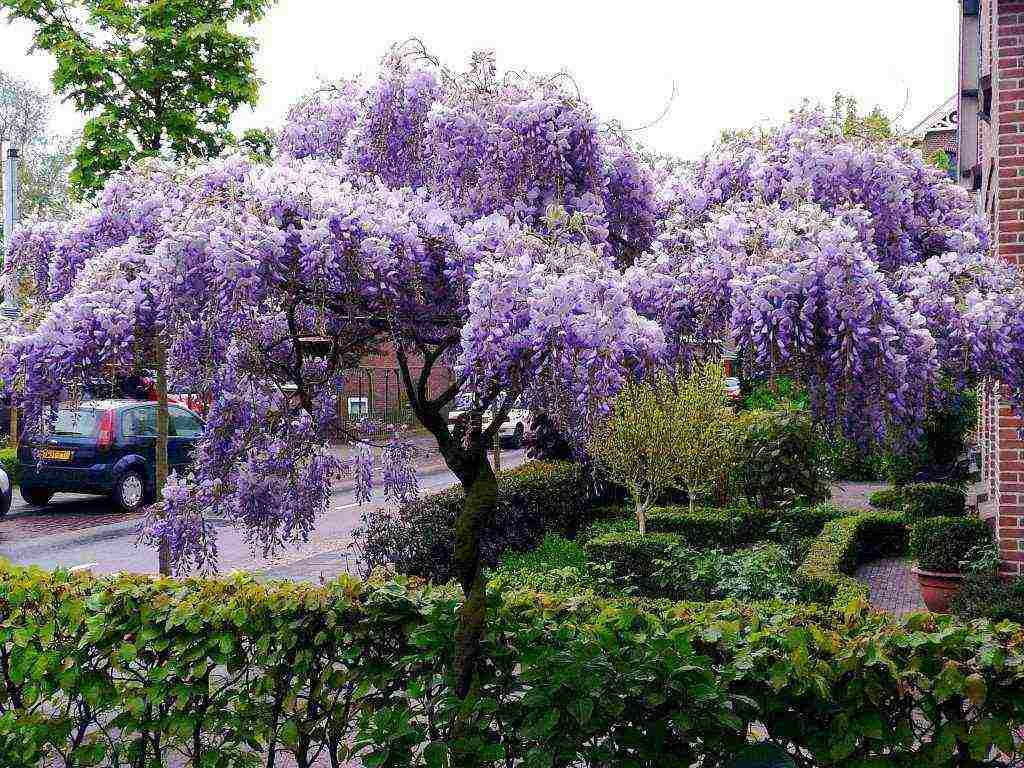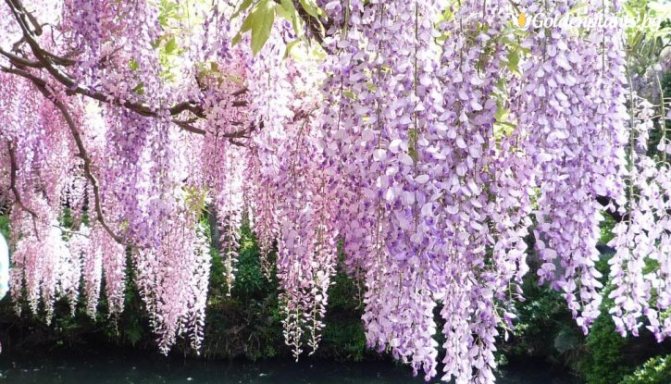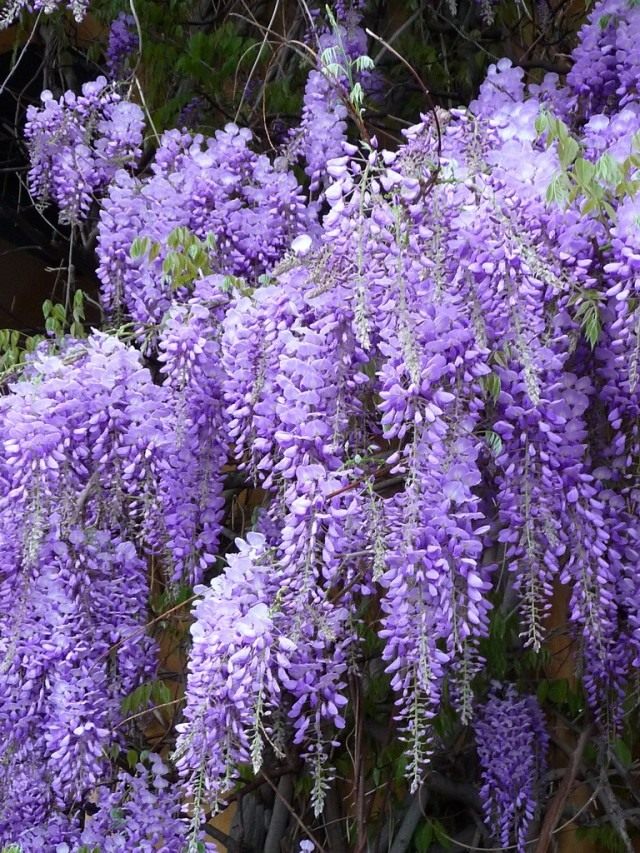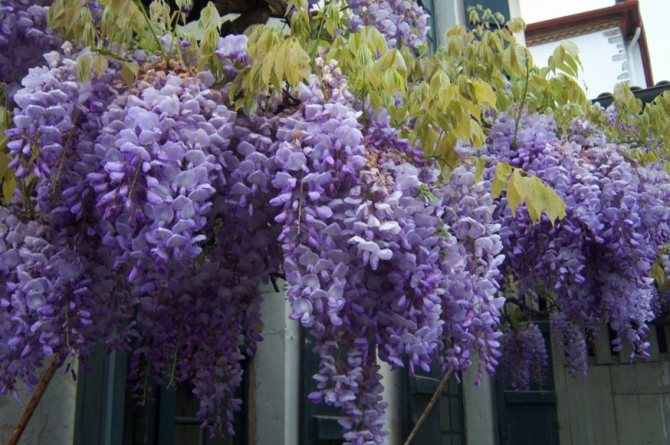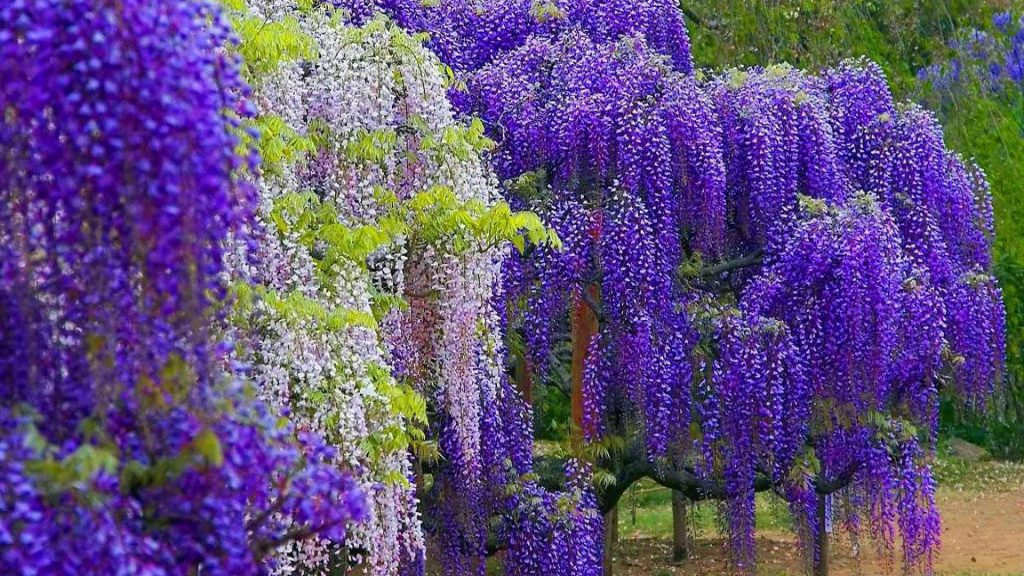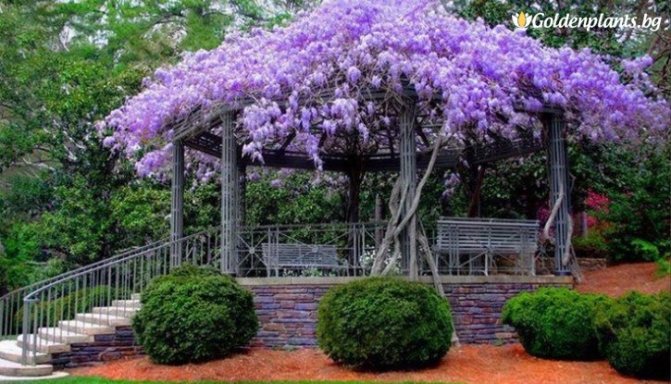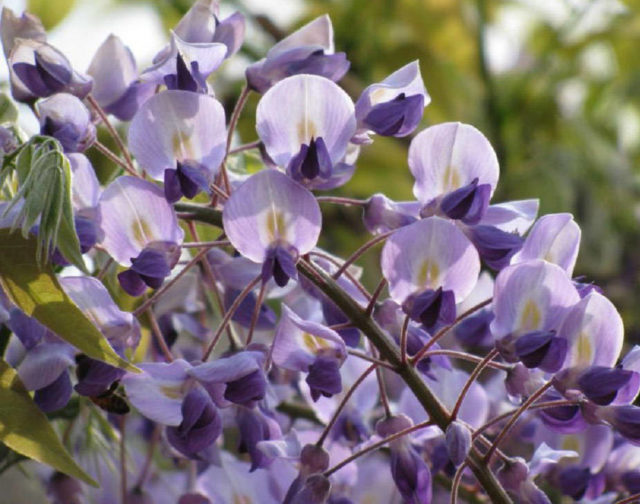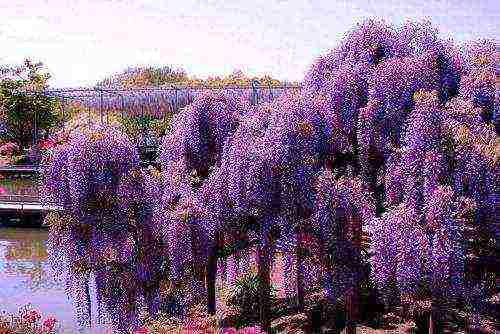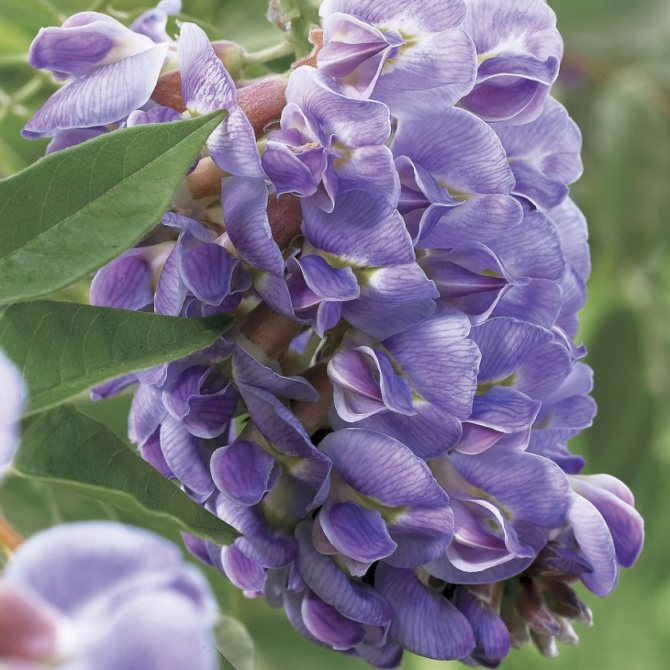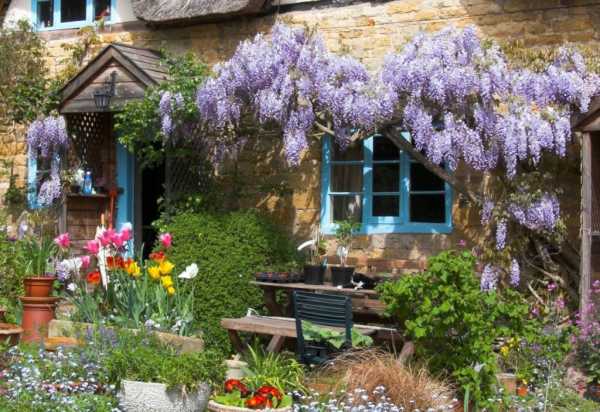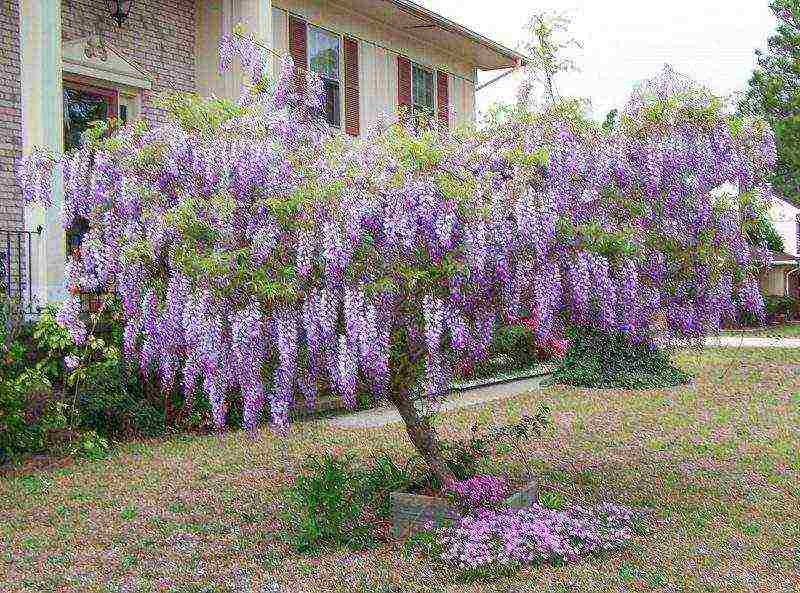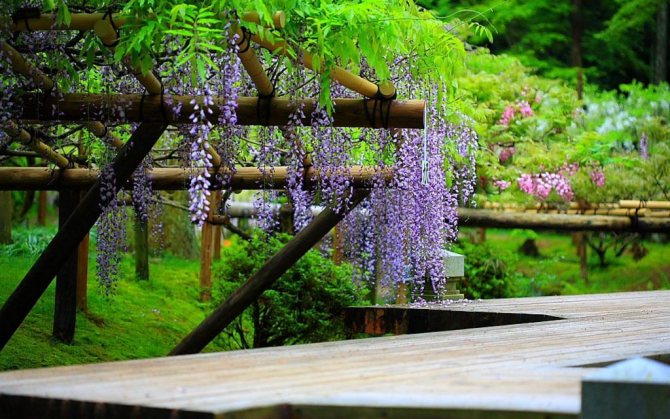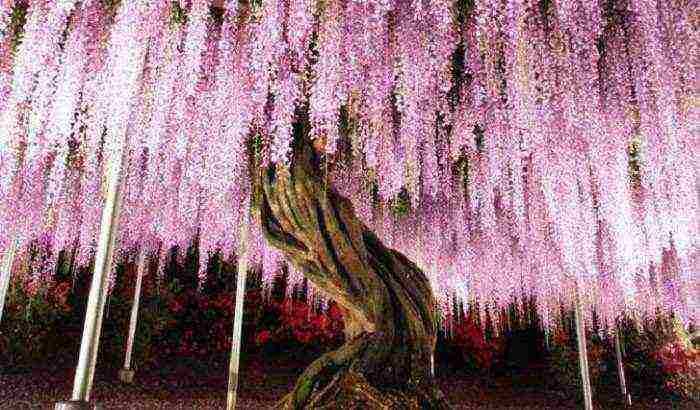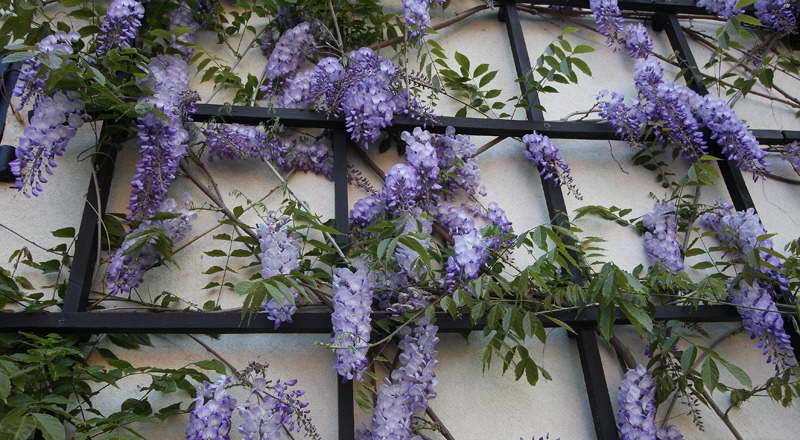Growing thermophilic wisteria

Planting wisteria
Layering in spring and summer. For cuttings we choose annual ripe shoots 20-25 cm long. They need to be rooted in soil from turf, peat, humus and sand (3: 1: 1: 1). At the end of summer, the rooted layers are planted.
Seeds. Note that the method is much more complicated than the first one. You can plant seeds in greenhouses in November-December or in the ground in spring. The soil should be loose - leafy, turfy soil and sand (4: 1: 1). Cover crops with glass or a plastic bag for high humidity
And we put it in a dark place - this is important. Seedlings should appear only after 3-4 weeks
Then we take out the seedlings into the light, slightly shading them, and dive when the first 2 leaves appear.
Growing wisteria
- Bright sun. For abundant flowering, wisteria should be in the sun for at least half a day.
- Strong supports, on which wisteria, which grows strongly over time, will curl.
- Moderate watering from spring to late summer - keep the soil slightly moist. Excess water does not tolerate well.
- Light nutritious soil.
- Top dressing with liquid fertilizer once a week during the budding period.
- Good shelter in winter, especially in central Russia. There are varieties that can withstand -20 ° C, but no more.
- Pruning at least 2 times for more abundant flowering. The first - at the end of flowering, while shortening all lateral shoots by two-thirds. The second is after falling leaves. All lateral branches are cut off, leaving only 3-5 buds.
Types of wisteria
Chinese wisteria (Wisteriachinensis) has spectacular light purple, rarely white flowers. It can grow up to 15-20 m. The foliage is dense, the clusters of inflorescences are 30 cm long. It blooms almost all summer. Forms fruits - beans up to 15 cm long. It is widely distributed in the south of Russia and, accordingly, is very thermophilic. If the vine is systematically cut off, it can be grown in a tree-like standard form.

Abundantly flowering, or multi-flowered wisteria (Wisteria floribunda) with violet-blue flowers. Reaches 8-10 m. The brushes of this wisteria are longer than the previous one - 50 cm. And it blooms 2-3 weeks later. It is more frost-resistant (down to -23 ° C) than Chinese wisteria.
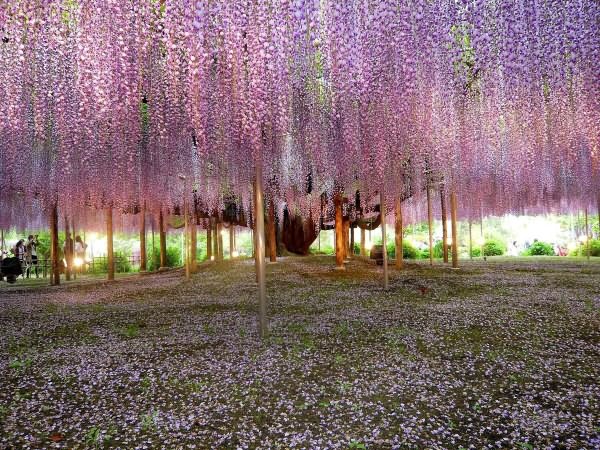
Beautiful wisteria (Wisteria venusta) with double white and purple flowers. It can grow up to 10 m. The length of the inflorescences is about 20 cm. Flowering lasts from May to June. The fruits are beans 20 cm in size.

Shrub wisteria (Wisteria frutescens) has a purple-blue smaller size than Wisteria venusta. Reaches 12 m in height. It has been growing in Crimea for a long time. Can be grown in a container.
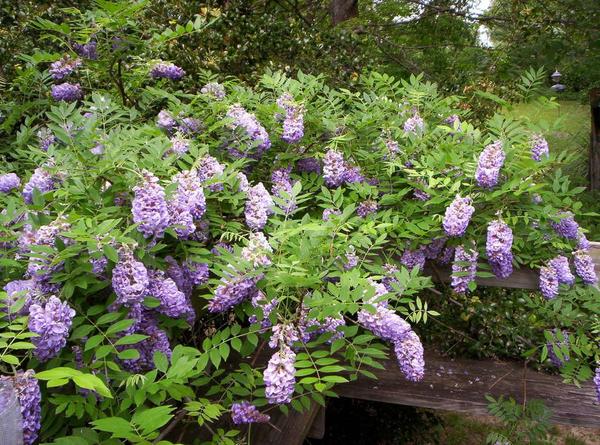
Japanese wisteria (Wisteria japonica) has white flowers. Less hardy and beautiful than other species. Grows on the Black Sea coast of the Caucasus.
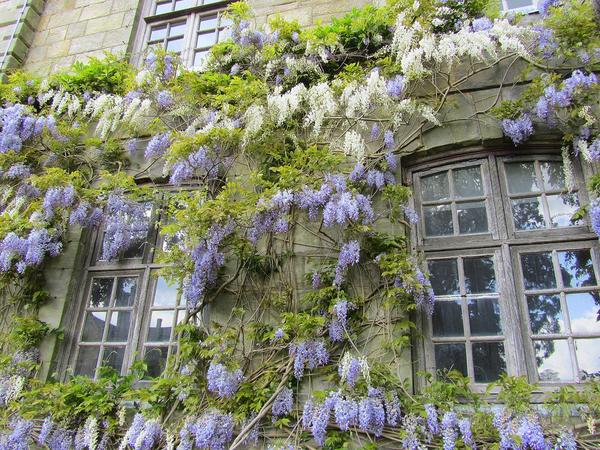
Vera, Biysk
MarfaA, thank you very much for your informative answer. The decision was made, in the spring I buy a seedling. I already know where I will put him.
Lyudmila Uleyskaya, Yalta
Lyudmila Uleiskaya, Yalta
Lyudmila Uleiskaya, Yalta
marishkawork, mine also did not react in the first year, it probably took root. In the second year it gave an increase from 30 cm to 3 meters. This year I hope to see flowering. But! The plant must be cut in autumn and spring, each branch is a third from the end. Also take an interest in the articles, I do not remember exactly, it seems that flower buds are laid on the branches of second years. In general, I want to say to those who are still tormented by the question of seeds or seedlings. I came to the conclusion -better seedlings. Advantages: 1) Saving time for growing to a full-fledged seedling, 2) A varietal seedling is grafted (which, in the absence of experience, cannot be done by yourself, because the grafting is done at the root) 3) flowering begins significantly earlier (when grown from seed, up to 8 -10 years, and from soot-for 4-5 years).

Lyudmila Uleiskaya, Yalta
Lyudmila Uleiskaya, Yalta
views
Lyudmila Uleiskaya, Yalta

.
- Reproduction of wisteria
- Propagate wisteria
- How to plant wisteria
- Wisteria china
- How to grow wisterias from seeds
- Blooming wisteria
- Grow wisteria from seeds
- Growing wisteria
- Wisteria varieties
- Photo of wisteria seeds
- Wisteria garden
- All About Chinese Wisteria
- Wisteria cultivation
- Wisteria propagation by cuttings
- When wisteria blooms
- When to plant wisteria
Fruiting wisteria macrostachia and sowing seeds
I could not find any specific recommendations for germinating macrostachia wisteria seeds, so I had to experiment with crops.
I sowed one third of the wisteria seeds in a box immediately after harvest and left them in the garden to undergo natural stratification.
I kept the remaining wisteria seeds until spring in a cool place (+ 10C). In early March, I sowed them in light soil. Contained crops of wisteria in a warm, at a temperature of + 25C. My experience has shown that macrostachia wisteria seeds begin to germinate as early as the fifth day. The germination rate of these seeds turned out to be almost one hundred percent.
Ha photo: shoots of wisteria; wisteria seedlings
In the garden in the spring, I saw that the seeds of wisteria macrostachia, which had passed cold stratification, also sprouted. However, their germination rate was no more than 60 percent.
And in the spring of last year (2011), I discovered self-seeding in our wisteria. Seedlings emerged from seeds that fell in April from those few beans that I left to winter on the liana. This fact is the most important evidence for the successful adaptation of wisteria macrostachia. After that, we can say with complete confidence that our flowering and fruiting plant is fully adapted to the local climatic conditions.
What you can eat at high pressure
|
Allowed foods for hypertension |
Foods that can be consumed in limited quantities |
|
|
Consider what foods should not be consumed by hypertensive patients:
- rich pastries, cakes, pastries, biscuits, fried flour products;
- fatty meats and fish, smoked, pickled, canned products, sausages;
- semolina;
- strong coffee and tea, cocoa, sweet carbonated drinks;
- soups cooked with fatty fish and meat;
- ice cream, chocolate;
- Salo;
- hot spices, marinades, sauces;
- mayonnaise;
- alcohol.
It should be noted in advance that many "taboo foods" are not recommended for eating, even for people with a healthy cardiovascular system. Therefore, abandoning them will benefit any person.
Products, the use of which needs to be minimized, and it is better to completely abandon:
-
Fatty meat is the main source of cholesterol. You can forget about high-fat red meat. All derived products are also excluded from the diet: sausage, minced meat, bacon, entrails, etc. Rich broths are also unacceptable;
-
Cakes, cookies, sweets, any baked goods - the synthesis of sugar and fat. As a rule, it is difficult for a person to control the amount of sweets eaten, so healthy carbohydrates should be preferred;
-
Coffee, cocoa, chocolate - caffeine negatively affects the work of blood vessels, artificially causing spasms;
-
Nicotine. Smoking and hypertension are incompatible concepts. During the day, the vascular system of the smoker suffers numerous malfunctions and becomes unable to independently regulate all processes.
What should not be eaten for people who often have high blood pressure:
- Strong tea, brewed coffee, alcoholic beverages are prohibited. Any of these drinks will raise upper diastolic blood pressure within 40 minutes after drinking. Dangerous for hypertensive patients and caffeine, which is contained in Coca-Cola, chocolate, coffee.
Alcohol and smoking are the main enemies of the heart and blood vessels.
Starting with grade 1 hypertension, you need to limit the use of strong alcoholic beverages to 30 grams per day.
- Any therapist will tell you to limit your dietary intake of animal fat and cholesterol. Fat-like substances accumulate in the arteries, which leads to their deformation and narrowing. Blood does not feed the heart properly and blood pressure rises. The most dangerous complication in such cases is atherosclerosis and stroke. Hypertensive patients of the 2nd degree of pathology, and especially the elderly, need to constantly monitor their cholesterol levels.
Cholesterol should not be higher than 250 mg
You should limit yourself in eating chicken eggs, confectionery products, mayonnaise, sauces, liver, caviar, smoked meat, butter.
- In hypertension, the main irritant in the failure of blood pressure is table salt. For a healthy life, you need to reduce the consumption of table salt to a minimum. Nutritionists say that eating more than 5 grams of sodium chloride a day can not only increase blood pressure, but also often cause obesity.
- You need to drink at least 1 liter of water a day. Drinking more than 2 liters of water is also not good for the circulatory system. The norm for hypertensive patients is 1.5 liters per day.
Find out your level of risk of heart attack or stroke
Take a free online test from experienced cardiologists
Testing time no more than 2 minutes
- Strong tea;
- Coffee;
- Fat meat;
- Canned food;
- Pastries and white flour products;
- Confectionery with cream;
- Ice cream;
- Potato;
- Semolina;
- Alcohol;
- Carbonated drinks.
Features of growing wisteria of different varieties
Before buying a vine seedling and planting it in your garden, you should find out which species are suitable for our climatic conditions and what are the features of their cultivation. Wisteria as a genus includes 9 species, but only three are suitable for our area: Chinese, frost-resistant, profusely flowering. When breeding such vines, it is necessary to ensure the following conditions:
- Bright sun. Abundant flowering of wisteria can only be obtained in a sunny area.
- A solid foundation. Liana is a climbing plant, and it needs a good, strong support on which it will grow.
- Stable watering. From spring to summer, the land on which the wisteria grows must be kept moist. The main thing is not to overdo it, the plant does not tolerate excess moisture.
- Top dressing with fertilizers. Like other plants, wisterias need fertilization, especially during the budding period.
- Thorough shelter for the winter. Despite the fact that such a vine is a frost-resistant plant, it is recommended to wrap its twigs with leaves, paper, roofing felt or special covering material for the winter.
- Pruning. For dense flowering, wisteria is cut off 2 times a year (at the end of flowering, after leaf fall).
If the climatic conditions of your region do not allow growing a vine outdoors in the open field, try planting it in a flowerpot, like a standard tree. In autumn and winter, it will decorate the hallway or hall of your home, and in spring and summer it will embellish the terrace or entrance to the house. To form a wisteria crown, you will need to prune the young side shoots several times in the spring.
Chinese (Wisteriachinensis)
The birthplace of tree-like wisteria is China. The plant is characterized by a dense foliage, the length of the shoots reaches 15-20 m in height. The leaf of Chinese wisteria is large (20-30 cm long), has a complex odd-pinnate shape and consists of 7-13 small leaves.The liana blooms with light purple (in rare cases, white) flowers, which are collected in a 40 cm brush and all bloom at the same time. Flowering begins with the appearance of foliage and lasts until the end of summer. This is often repeated in early September.
Wisteria is a thermophilic and light-loving plant, but it develops well in the shade. It is not particularly demanding for the soil, but it is preferable to plant the plant on fertile, moist soil. This vine is well adapted to urban conditions, withstands a short-term drop in temperature to -20C. Wisteria grows quickly, lifting stems up the support from right to left. With systematic pruning, the plant is suitable for growing in pots and tubs.
Frost resistant (Blue Moon)
This plant is native to North America. Wisteria Blue Moon is fast-growing, its maximum length is 8 m. The bush has unpaired leaves (consists of 7-9 leaves) of glossy dark green color. The inflorescence is abundant and dense, reaches a length of 25-30 cm, consists of bluish or blue-purple flowers. Frost-resistant wisteria blooms in early June and blooms for 2-3 weeks.
The main feature of this vine is its good tolerance to extreme cold temperatures down to -40C. It is advisable to plant a plant in a sunny area or on the south side of the building. Wisteria grows on any type of soil, but in order to achieve maximum flowering results, it is recommended to grow it on black soil or loam. It is not recommended to plant a bush in swampy, calcareous places. This type of wisteria is not picky about watering and tolerates drought well. Only young plants need to be systematically watered.
Abundantly flowering or multi-flowered (Wisteria floribunda)
This wisteria was originally developed in Japan. The height of the vine reaches 8-10 meters, has very large leaves (40 cm) with 15-19 small leaves. The size of the clusters of inflorescences reaches 50-70 cm. Wisteria blooms after the leaves bloom, in the second half of May, sometimes again at the end of summer. Flowers bloom gradually, starting from the base of the brush, ending with the bottom.
Multi-flowered wisteria withstands frosts well down to -25C. For lianas, sunny areas with light, moderately moist, loose soil, without stagnant water rich in nutrients, are preferred. Multiflorous wisteria twines around the support with stems only clockwise. The color range of flowers is varied: white, pale pink, pale purple, reddish.
Wisteria in landscape design
The tea ceremony, borrowed from China, has become an integral part of Japanese culture. In the XII-XV centuries. the first tea ceremonies were held in Buddhist temples of the Zen sect.

Later, for this purpose, they began to equip special tea pavilions, near which gardens were laid out.
The tea garden is one of the Japanese landscaping styles.
In such a garden, there must be a tea house and a vessel for washing hands. The garden of the tea pavilion symbolizes the 4 seasons, demonstrating the beauty of changing nature - blooming camellias represent winter, sakura and azaleas bloom in spring.
In the summer, forming a cascade, lilac bunches of wisteria hang down, in the fall maple leaves and nandina berries are on fire.
Streams of falling wisteria flowers - there is no more beautiful sight. Tourists from all over the world come to Japan in spring to admire the picturesquely blooming wisteria.
Flowers or liana wisteria - description and photo of the plant
Among florists, there are constant disputes over the definition of the species of this plant. Flowers or liana? Rather, a tree. Wisteria belongs to the legume family and naturally grows in the southern and tropical regions. Does not experience any problems with growth, development and abundant flowering in the climatic conditions of the Crimean Peninsula, Kuban, North Caucasus, Mineralnye Vody.It is there that you can see unusual tunnels, entwined pergolas and decorated hedges using similar vines.
When describing a plant, it should be immediately clarified that in cold, harsh and long winters, only the root system and young growth can be preserved. And flowering occurs only on vines that have reached the age of 6-8 years. Moreover, in the suburbs in the cold and rainy summer, it is extremely difficult to force wisteria to bloom. She needs an abundance of sunlight and a constant ambient temperature without sudden changes in the night and day.
Under suitable growing conditions, the wisteria flower blooms 2 times per season. The first brushes bloom in early spring until the feathery leaves appear. The second wave of flowering occurs in early August. The Latin name for the culture is Wisteria.
It is a ligneous liana that does not grow rapidly. Usually, during the season, an increase in the vegetative mass of the shoots is achieved only by 20 - 30 cm. It can grow to the height of the wall 5-7 years after planting. Large deciduous mass perfectly decorates any surface, but racemose inflorescences, the length of which reaches 35 cm, are of particular interest.
Look at the photo of wisteria at the time of its flowering - this is a magnificent sight, striking the imagination with its beauty and grace:
Growing Blue Moon wisteria in our garden
Wisteria settled in our garden a few years ago (spring 2008). Moreover, at that time, the acquisition of wisteria was rather an impulsive act dictated by necessity. On our site, we made a resting corner, put a support over it. An interesting liana was needed, which would form a shadow over the benches. The choice of beautiful lianas in our climate is small, but I wanted to plant something unusual ...
We were offered to buy cold-resistant wisteria, which can withstand even severe frosts (-40C). This is how we got wisteria macrostachia, or large-leaved (Wisteria macrostachya). And my acquaintance with her variety "Blue Moon" ("Blue Moon", translated as "Blue Moon") began. The homeland of this plant is the USA, Minnesota.
The purchased wisteria seedling was small, no more than 30 cm long. Now, looking back, I can honestly admit: at that moment I had great doubts that this baby would quickly braid the provided support and give at least some shadow ... didn’t even dream.
Imagine my surprise when a wisteria sapling planted in early June (in standard Voronezh chernozem), a month after adaptation, began to develop rapidly. By August, the height of the plant was more than two meters!
Before the onset of the first frosts, we removed the wisteria from the support - along with the ropes for which its shoots clung. They laid the vine on the boards, covered it with moss and lutrasil on top.
Planting seedlings and wisteria seeds and subsequent plant care
In the presence of favorable climatic conditions, an effective way of breeding lianas is a pre-grown planting material prepared in advance. Wisteria seedlings are offered by many agricultural firms that professionally breed rare plants. In this case, the procedure for planting wisteria is not difficult: a plot of land is prepared, holes are dug up to 20 cm deep, nutritious soil, humus and mineral fertilizers are laid in them, and direct rooting is carried out.
Watering after planting is done daily at 2-2.5 liters for each plant. Effectively mulch the soil with fresh cut grass. This ensures that the optimum level of soil moisture is maintained even during dry periods of summer.
Reproduction in the future is possible by cuttings and rooting of cuttings obtained during pruning from an adult tree. For this, shoots with an age of 1 year or more are selected and cut into cuttings up to 25 cm long.The cut is processed with crushed charcoal or wood ash and dried. After that, digging is carried out to a depth of 5 cm into a mixture of turf soil, humus and sand. After 40 - 45 days, the cutting develops a powerful root system and it can be transplanted to a permanent "place of residence".
Planting wisteria seeds will require patience from the gardener due to the extremely slow growth and development of the plant in the first 5 years. Sowing is carried out in the first half of February, for germination requires a high level of humidity, high temperature (about 30 degrees Celsius) and complete darkness. Therefore, the container is closed with black polyethylene and placed in the warmest place of the house or apartment. The first shoots can be seen after 1 calendar month. In phase 4 of these leaves, a pick is carried out in a container with a volume of at least 500 ml. During the period of growing wisteria seedlings, you should protect the sprouts from exposure to direct sunlight and monitor the constant moisture of the soil mixture. Top dressing is carried out once a week with complex mineral compounds dissolved in water.
Subsequent care of the wisteria plant includes providing favorable conditions for its growth. In order to get abundant flowering, you need a long daylight hours, the sun must shine for at least 12 hours. If this does not happen, the inflorescences become small and less expressive in color.
Light and well-structured soil with obligatory laying of drainage to remove excess moisture ensures fast and stable growth of wisteria vine.
During the formation of buds, care for wisteria includes the introduction of mineral and organic dressings 1 time in 3 days
This is important to ensure the rich color of the inflorescences.
For 1 vegetative season, 2 planned pruning is carried out in order to form a lush crown. The first pruning is required in the spring, when no more than 5 strong axillary buds are left on the shoots. The second pruning is carried out in the fall, before the vines leave for the winter.
By the way, with a sufficient level of insulation and shelter, the plant can quite overwinter in the open ground, if the ambient temperature in the growing area does not drop below minus 20 degrees Celsius. In all other cases, it is advisable to grow the culture in containers, which are brought into a heated room for the winter.
Wisteria in Asia
In East Asia, wisteria begins to bloom in April, reaching its maximum bloom in mid-May and symbolizing the onset of summer.
In Japan, wisteria is called "fuji", in Europe - "wisteria".
The flower as an image, according to the Japanese, is ideal for the biography of any person.
Life is like flowering: growth, flourishing and withering. Flower images are an indispensable part of Japanese everyday life.
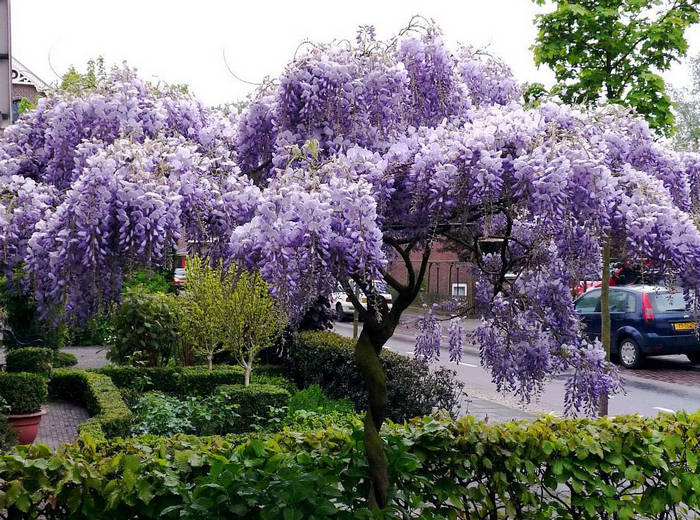
The ornament on the spring kimono, depicting an old moss-covered pine tree entwined with wisteria, symbolizes well-being, prosperity and success.
In the old days, wisteria-colored winter clothes were worn - a lilac top lined with green lining.
In Ishikawa Prefecture, at the Ochinushi Shrine, there is a festival associated with the flowering of the plant.
For the holiday, chariots are prepared, performing ritual actions - instead of nails and ropes, strong and long wisteria vines are used.
In the garden of Kawachi Fuji, which is located near Tokyo, many unique varieties of this flower are collected.
How to care for wisteria at home
If you decide to decorate your apartment or garden with this outlandish plant, you definitely need to familiarize yourself with the recommendations for caring for it.
Lighting
Wisteria is a long-liver; in nature there are trees that are 100-150 years old. It is appreciated for its exuberant flowering, which largely depends on the place of planting. Wisteria is a light-loving plant, therefore it is recommended to place it in well-lit places.For at least 5-6 hours a day, the vine should be exposed to direct sunlight. Otherwise, the leaves will fade, and the inflorescences on the tree will be much smaller. The best choice would be the location of the wisteria near the southern wall of the house, where it will be protected from drafts, strong winds and will be able to get enough of the sun's rays.
Wisteria is very fond of sunlight, so it should be placed on the south side of the house.
Temperature
The main factor that for a long time prevented the spread of wisteria in our country is its thermophilicity. The delicate plant simply could not withstand the harsh Russian winters, because its homeland is the subtropical regions. Fortunately, many years of work of breeders have borne fruit and now on the market you can find many varieties that can withstand temperatures from - 20 ° C to - 40 ° C. The optimum temperature for wisteria in the summer is 20-30 ° C. In winter, homemade wisteria requires special care, so we recommend moving it to a room with a temperature of 10-15 ° C. In spring, the tree should be placed on a balcony or terrace.
Some types of wisteria can withstand the high freezing temperatures of Russian conditions
Humidity
From the beginning of flowering, it is necessary to regularly sprinkle wisteria with warm, settled water. Their frequency should be determined based on the air temperature. From the beginning of autumn, the number of spraying must be reduced, and in winter it must be stopped altogether.
Watering
The plant requires regular watering, but does not tolerate excess moisture. Excessive moisture can cause the leaves to fall off and the buds shed by the wisteria. In early spring, when the herbaceous vine is preparing to bloom, it needs to be watered frequently and abundantly. Once the buds are formed, it should be reduced slightly so as not to harm the wisteria. The soil should be slightly damp, so water only as needed. In early October, the amount of watering should be minimized, since during this period the plant begins to prepare for wintering.
Wisteria does not tolerate overflow, it needs moderate watering
Top dressing
Liana is characterized by a fairly rapid growth: in one season, shoots can grow by 1-3 meters. Naturally, this requires a significant amount of energy from the plant. Experts recommend regular feeding with complex mineral fertilizers to stimulate abundant flowering and rapid growth of wisteria.
For faster growth, wisteria is fed with mineral fertilizers
Bloom
Depending on the variety, wisteria blooms can last from 2 weeks to a month. Some hybrids bloom up to 2-3 times per season. During this period, the flower requires frequent spraying, moderate watering and frequent feeding. It is advisable to prune vines from time to time, removing dried or faded inflorescences. Also, in advance, take care of the support from which the racemose buds will beautifully descend.
Wisteria blooms for a very long time and in the warm season, wisteria releases brushes - inflorescences




